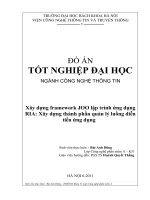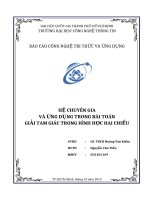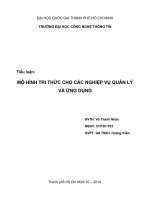Nghiên cứu phát triển một số giao thức tính tổng bảo mật hiệu quả trong mô hình dữ liệu phân tán đầy đủ và ứng dụng
Bạn đang xem bản rút gọn của tài liệu. Xem và tải ngay bản đầy đủ của tài liệu tại đây (1.57 MB, 246 trang )
MINISTRY OF EDUCATION VIETNAM ACADEMY OF SCIENCE
AND TRAINING AND TECHNOLOGY
GRADUATE UNIVERSITY OF SCIENCE AND TECHNOLOGY
Vu Duy Hien
DEVELOPING EFFICIENT AND SECURE MULTI-PARTY
SUM COMPUTATION PROTOCOLS
AND THEIR APPLICATIONS
DISSERTATION ON INFORMATION SYSTEM
Hanoi – 2024
BỘ GIÁO DỤC VIỆN HÀN LÂM KHOA HỌC
VÀ ĐÀO TẠO VÀ CÔNG NGHỆ VIỆT NAM
HỌC VIỆN KHOA HỌC VÀ CÔNG NGHỆ
Vũ Duy Hiến
NGHIÊN CỨU PHÁT TRIỂN MỘT SỐ GIAO THỨC TÍNH
TỔNG BẢO MẬT HIỆU QUẢ TRONG MƠ HÌNH DỮ LIỆU
PHÂN TÁN ĐẦY ĐỦ VÀ ỨNG DỤNG
LUẬN ÁN TIẾN SĨ NGÀNH HỆ THỐNG THÔNG TIN
Hà Nội – 2024
BỘ GIÁO DỤC VIỆN HÀN LÂM KHOA HỌC
VÀ ĐÀO TẠO VÀ CÔNG NGHỆ VIỆT NAM
HỌC VIỆN KHOA HỌC VÀ CÔNG NGHỆ
Vũ Duy Hiến
NGHIÊN CỨU PHÁT TRIỂN MỘT SỐ GIAO THỨC TÍNH
TỔNG BẢO MẬT HIỆU QUẢ TRONG MƠ HÌNH DỮ LIỆU
PHÂN TÁN ĐẦY ĐỦ VÀ ỨNG DỤNG
LUẬN ÁN TIẾN SĨ NGÀNH HỆ THỐNG THÔNG TIN
Mã số: 9 48 01 04
Xác nhận của Học viện Người hướng dẫn 1 Người hướng dẫn 2
Khoa học và Công nghệ (Ký, ghi rõ họ tên) (Ký, ghi rõ họ tên)
GS. TSKH. Hồ Tú Bảo PGS. TS. Lương Thế Dũng
Hà Nội - 2024
i
PLEDGE
I promise that the thesis: ”Developing efficient and secure multi-party
sum computation protocols and their applications” is my original research
work under the guidance of the academic supervisors. All contents of
the thesis were written based on papers and articles published in
distinguished international conferences and journals published by the
reputed publishers. The source of the references in this thesis are
explitly cited. My research results were published jointly with other
authors and were agreed upon by the co-authors when included in the
thesis. New results and discussions presented in the thesis are perfectly
honest and they have not yet published by any other authors beyond
my publications. This thesis has been finished during the time I work
as a PhD student at Graduate University of Science and Technology,
Vietnam Academy of Science and Technology.
Hanoi, 2024
PhD student
Vu Duy Hien
ii
ACKNOWLEDGEMENTS
Scientific research is an interesting journey where the thesis is
one of the first results that researchers have reached. On that journey,
I have met many kind people who have supported for me to finish
this thesis.
First of all, I would like to thank my great supervisors Prof. Dr.
Ho Tu Bao and Assoc. Prof. Dr. Luong The Dung who have provided
valuable advice to me. Without their support and guidance, I would
not able to complete my thesis. I have learned a lot of things from
my supervisors.
I am thankful to Graduate University of Science and Technology,
colleagues at Banking Academy of Vietnam, friends, and collaborators who
always encour- age me along my research journey.
I also thank the CAMEL cafe (No.104/1 Viet Hung street, Long Bien
dis- trict, Ha Noi) where my publications and thesis had been born in.
Finally, I want to send the most special thank to my big family, my wife,
and
our children who always have my back.
Hanoi, 2024
PhD student
Vu Duy Hien
iii
CONTENTS
INTRODUCTION................................................................................1
1 OVERVIEW OF SECURE MULTI-PARTY SUM COMPUTATION 7
1.1 Background of secure multi-party computation 7
........... .
1.1.1 Introduction . . . . . . . . . . . . . . . . . . . . . . . . . 7
. .
1.1.2 Basic concept . . . . . . . . . . . . . . . . . . . . . . . . . . 10
1.1.3 Definition of security . . . . . . . . . . . . . . . . . . . . 11
. .
1.1.4 Cryptographic preliminaries . . . . . . . . . . . . . . . . . 18
.
1.2 Secure multi-party sum computation problem . . . . . . . 22
. . . . . .
1.2.1 Problem formulation . . . . . . . . . . . . . . . . . . . . 22
. .
1.2.2 Related work . . . . . . . . . . . . . . . . . . . . . . . . 24
. .
1.3 Conclusion . . . . . . . . . . . . . . . . . . . . . . . . . . . . . . . 35
2 PROPOSING EFFICIENT SECURE MULTI-PARTY SUM COMPUTA-
TION PROTOCOLS 36
2.1 Analysis of typical secure multi-party sum computation protocols 36
2.1.1 Simple secure multi-party sum computation protocol.......36
2.1.2 Secure multi-party sum computation protocol of Urabe et al.
38
2.1.3 Secure multi-party sum computation protocol of Hao et al.,
2010 in an electronic voting system.............................40
2.1.4 Privacy-preserving frequency computation protocol of Yang
et al..........................................................................44
2.1.5 Further discussion.........................................................47
2.2 Proposed secure multi-party sum computation protocols............49
2.2.1 Privacy-preserving frequency computation protocol
based on elliptic curve ElGamal cryptosystem
2.2.2 iv
50
An efficient approach for secure multi-party sum
computation without pre-establishing
secure/authenticated channels
61
v
2.2.3 Secure multi-sum computation protocol...........................78
2.3 Conclusion...............................................................................91
3 DEVELOPING NEW SOLUTIONS BASED ON SECURE MULTI-PARTY
SUM COMPUTATION PROTOCOLS FOR PRACTICAL PROBLEMS
93
3.1 An efficient solution for the secure electronic voting scheme without
pre-establishing authenticated channel.......................................93
3.1.1 Introduction..................................................................93
3.1.2 Related work.................................................................94
3.1.3 Preliminaries.................................................................96
3.1.4 A secure end-to-end electronic voting scheme............97
3.1.5 Security analysis...........................................................99
3.1.6 Experimental evaluation..................................................102
3.2 An efficient and practical solution for privacy-preserving Naive
Bayes classification in the horizontal data setting
103
3.2.1 Introduction.................................................................104
3.2.2 Related work...............................................................107
3.2.3 Preliminaries...............................................................109
3.2.4 New privacy-preserving Naive Bayes classifier for the
hori- zontal partition data setting
112
3.2.5 Privacy analysis...........................................................115
3.2.6 Accuracy analysis........................................................115
3.2.7 Experimental evaluation..................................................115
3.3 Conclusion.............................................................................120
CONCLUSION......................................................................................122
BIBLIOGRAPHY...................................................................................124
APPENDICES.......................................................................................137
PUBLICATION LIST........................................................................140
vi
LIST OF ABBREVIATIONS
BoW..................Bag-of-Words
CDH..................Computational Diffie-Hellman
DDH..................Decisional Diffie-Hellman
DD-PKE............Public-key encryption with a double-decryption algorithm
DNA...................Deoxyribonucleic acid
DRE...................Direct-recording electronic
DSS....................Digital signature standard
E2E....................End-to-end
LWE..................Learn with error
NSC...................National university of Singapore short text messages corpus
PPFC.................Privacy-preserving frequency computation
PPML................Privacy-preserving machine learning
PPNBC..............Privacy-preserving Naive Bayes classification
PSI.....................Private set intersection
RAM..................Random Access Machines
SMC..................Secure multi-party computation
SMS...................Secure multi-party sum
SSC....................Secure sum computation
TF-IDF..............Term frequency – inverse document frequency
UK.....................United Kingdom
ZKP...................Zero knowledge proof
vii
LIST OF TABLES
2.1 The brief comparisons of the computational complexity
among three typical SMS protocols
48
2.2 The computational complexity comparisons among the proposed
pro-
tocol and the typical protocols................................................56
2.3 The communication cost comparisons among the typical PPFC
protocols. 57
2.4 The stored data volume of the miner comparisons among the
typical
PPFC protocols (in megabytes).....................................................62
2.5 The comparisons of each user’s computational complexity
among the proposed protocol and the typical protocols.
72
2.6 The miner’s computational complexity comparisons among
the pro- posed protocol and the typical protocols.
72
2.7 The comparisons of each user’s communication cost
among the pro- posed protocol and the typical protocols.
74
2.8 The comparisons of the miner’s communication cost among
the pro- posed protocol and the typical protocols.
74
2.9 The stored data volume of the miner comparisons among
the pro- posed protocol and the typical protocols (in
megabytes).
78
2.10The computational complexity comparisons among the new
proposal
and the typical solutions.........................................................86
2.11 The communication cost comparison among the new proposal
and the typical solutions.
viii
87
2.12The running time for the miner to compute the sum values compar-
isons among the compared solutions (in seconds).................91
2.13The stored data volume of the miner comparisons among the com-
pared solutions (in megabytes)...............................................91
3.1 Spam short-messages dataset information................................118
ix
3.2 The running time comparisons among the new proposal and the
typi-
cal PPNBC solutions on the real dataset (in seconds)............119
x
LIST OF FIGURES
1.1 The distributed computing model in a secure manner.............8
1.2 An example of the authentication method without knowing
user’s password
8
1.3 An example of monitoring user’s passwords............................9
1.4 An example of the DNA pattern-matching problem........................9
1.5 The secure electronic sealed-bid auction model.....................10
1.6 The real and ideal models in distributed computing field.......15
1.7 The computational model of the secure multi-party sum
computation problem
22
1.8 The single-candidate end to end decentralized e-voting model 23
1.9 An example of the privacy-preserving frequent itemset mining
problem 23
2.1 The computational model of the simple secure multi-party
sum com- putation protocol
37
2.2 The running time of each user comparisons among the typical PPFC
protocols.............................................................................59
2.3 The time for the miner/the server computing the public keys
compar-
isons among the typical PPFC protocols..................................60
2.4 The time for the miner/the server computing the frequency
value com- parisons among the typical PPFC protocols.
61
2.5 The running time of each user comparisons among the proposed
pro-
tocol and the typical protocols................................................75
2.6 The time of the pre-computation phase comparisons
among the pro- posed protocol and the typical protocols.
76
xi
2.7 The time of the user authentication phase comparisons
among the proposed protocol and the typical protocols.
77
xii
2.8 The time of the secure n-parties sum phase comparisons
among the proposed protocol and the typical protocols.
78
2.9 The number of private keys comparisons among the compared
solutions. 88
2.10 The total running time of each user comparisons among the
compared solutions.
89
2.11The running time for the miner to compute the public keys compar-
isons among the compared solutions......................................90
3.1 The single-candidate E2E decentralized electronic voting model. 96
3.2 The total running time of each voter comparisons between
the new solution and Hao’s scheme.
103
3.3 The voting server’s total running time comparisons
between the new solution and Hao’s scheme.
104
3.4 The horizontally distributed computing model...........................111
3.5 An example of data transformation.......................................112
1
INTRODUCTION
A. Motivation
Nowadays, the development of information technology and
communication, especially the birth of web applications or information
systems has created a large amount of data owned by organizations
or individuals. This has spurred the devel- opment of the distributed
computing field where the data owners perform together
computational tasks based on their cooperative data [1, 2]. Basically,
the distributed computing field has brought a lot of substantial benefits
to organizations and individ- uals, such asreducing significantly costs,
understanding comprehensively customers, and making good business
decisions. However, in fact, because of privacy policy or business
secrets, participants of distributed computing systems often wish to
ob- tain cooperative tasks’ correct output without revealing their input
data. For instance, some banks cooperate together to improve machine
learning-based credit scoring tool using their customers’ data, but they
are not ready to share their customers’ data for anyone. Similarly,
although there are some hospitals who want to jointly develop dis- ease
diagnosis methods based on a large united database, however they do
not want to provide their patients’ data to others. These challenges
had motivated the birth of SECURE MULTI-PARTY COMPUTATION area (SMC, for
short) that has been considered as a subfield of modern cryptography.
In essence, Secure Multi-party Computation refers distributed
computing methods in security concerns [1, 3]. Particularly, in a secure
multi-party computation model, there are several parties, in which each
participant owns a private input. These participants wish to obtain the
result of the specific function f over all private inputs while each party
reveals nothing about his/her input but the output result. Unlike
traditional cryptography field, the adversary of SMC problems in general
and the SMS problem in particular can be inside the system of
participants. The attacks of the ad- versary may be to learn the honest
2
participants’ private input or to cause the outputs to be incorrect [1].
As a result, the ”secure” term here means: (1) the output’s cor-
3
rectness is guaranteed, and (2) each party’s input is privately kept by himself/herself.
Nowadays, SMC has become an interesting topic that has
attracted more and more attention from research community. A
variety of SMC problems have been for- mulated and their solutions
have been proposed into SMC protocols, such as secure comparison
protocols [4,5], secure multi-party sum computation protocols [6–8], and
secure dot product protocols [6,9–11]. Furthermore, such SMC protocols
have been ap- plied to various practical problems, such as secure online
auction [14], secure e-voting systems [12,13], privacy-preserving queries
system [15], privacy-preserving financial data analytic [16], privacy-
preserving online advertising [17], and privacy-preserving machine
learning/data mining [18–20].
This thesis has investigated one of the most important and popular
SMC prob- lems [6] that is the secure multi-party sum computation one
(SMS, for short). In the SMS problem, it is assumed that where there
are some parties, in which each party owns a private value as his/her
input, and the parties wish to obtain the sum of all inputs but they
reveal nothing about their inputs beyond the sum value. Similarly to
SMC problems in general, the birth of SMS one has been based on
the security requirements of specific distributed computing problems.
Currently, a lot of proto- cols have been propounded for the SMS
problem, and they have a wide applicability in various practical computing
tasks, such as privacy-preserving recommendation sys- tem [21], privacy-
preserving multi-party data analytics [22], secure electronic voting system
[12, 13], privacy-preserving association rule mining [6, 7], privacy-
preserving classification [23], secure data collection for the smart
grid [24], and secure auc- tion [25, 26].
For SMC problems in general, and SMS one in particular, the
protocols must be secure (mainly including the preservation of the
privacy of the participants’ local inputs and the correctness of the
honest parties’ outputs [3]) enough to prevent the adversary’s harmful
behaviors. Besides, SMS protocols should be good performance (i.e. low
computational complexity and communication cost) to be
implemented in real-life applications. This is perfectly understandable,
4
because a lot of practical SMS problems require to perform
computational tasks as quickly as possible, such
5
as secure e-voting, secure online auction. SMS protocols-based privacy-
preservation solutions such as privacy-preserving Apriori algorithm for
mining association rules, privacy-preserving Naive Bayes classifier, and
secure gradient descent algorithm have to execute SMS protocol multiple
times to compute necessary mediate values. More- over, in many
distributed computing scenarios, participants use devices limited in
computational ability, storage capacity, and connectivity, e.g.
smartphones, tablets. Thus, it is significant to develop SMS protocols
having both high security level and good performance.
B. Research objectives
As mentioned before, first of all, SMS protocols need to be
secure. To do this, SMS protocols either (1) require each participant to
split his/her private value into a number of parts, and he then shares
them with all others using secure communica- tion channels or (2) use
homomorphic cryptosystems such as ElGamal encryption scheme [27]
or Paillier cryptosystem [28]. Considering the approach (1), such pro-
tocols obviously have high cost of communication, and they are
unsuitable for multi- party computational models with a large number
of participants. In contrast, SMS protocols based on the second
approach (2) often have pricey cost of computation. As a result, it can
be stated that the biggest challenge for designing SMS protocols is
how to create SMS protocols having both high security level and good
performance. Thus, the research objectives of this thesis include:
• Designing efficient and secure multi-party sum computation
protocols that have the capability to preserve the privacy of the
parties’ local inputs and the correctness of the honest parties’
outputs, as well as good performance.
• Developing SMS-based solutions for practical problems that have
been cur- rently solved by existing SMS protocols but are not
yet secure and efficient.
C. Main contributions
The scientific story of this thesis is narrated as follows:









